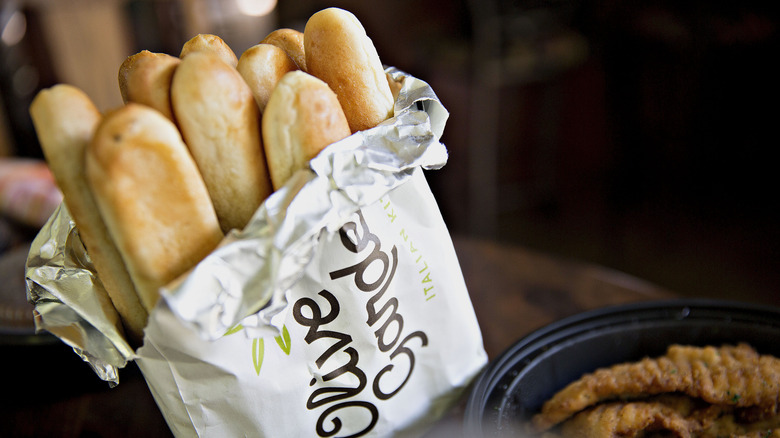Olive Garden's Breadsticks Are A Long Shot From The Real Italian Version
Americans love Olive Garden; the Italian family-style eatery is in many major cities and is the largest full-service casual chain restaurant in the country by sales — even if their menu isn't exactly authentic and traditional Italian cuisine. Yes, we're sorry to tell you that Pastachetti isn't a real Italian dish.
But, while it's no big shock that Olive Gardens don't exist in Italy (or anywhere in Europe for that matter), there's one item on the menu whose unauthentic nature may be surprising, and it has to do with the first thing many think of when the restaurant comes to mind: the breadsticks.
For all the deliciousness and popularity behind the chain's signature "never-ending" appetizer, it's not exactly what you'd find at an actual Italian family gathering. Italian cuisine has breadsticks, to be sure, but they look nothing like the kind you're used when dining at Olive Garden. Instead, Italian breadsticks are more akin to literal sticks made of bread.
Real Italian breadsticks might chip your teeth
It may seem weird to hear "breadsticks" and think of something without any fluffiness whatsoever, but that's what actually happens in true Italian cuisine. Real Italian breadsticks are called "grissini," and they're a far cry from what you're probably used to noshing on at Olive Garden. Not only is grissini longer and thinner, but their texture is totally different; they're so tough, you could literally snap them in half. (The jury is still out on which version your teeth might prefer.)
Unlike Americanized breadsticks, grissini actually have a history dating back hundreds of years. Supposedly, as a child, Amedeo II, the Duke of Savoy (where Turin is located), was weak and sickly, so the palace doctor recommended he eat food that was easily digestible. A local baker named Antonio Brunero thus created breadsticks, and things went from there. Whether this story is as typically apocryphal as a lot of food origin tales is up for debate — but we do know grissini have been around for centuries.
Other ways Olive Garden strays from real Italian cuisine
Breadsticks aren't the only way Olive Garden's practices stray from authentic Italian cuisine. The biggest rule Olive Garden may be breaking: Italians don't eat meat in their pasta, preferring protein to be its own course served after a plate of noodles. That means chicken fettuccine Alfredo isn't just inauthentic, but might be considered sacrilege to some Italians.
Alfredo sauce as we know it isn't exactly Italian, either. Although it was created in 1914 by a Roman chef named Alfredo Di Lelio, the real Italian form features only butter and parmesan — no cream or parsley to be found in the mix.
Even though Olive Garden may not be authentic, that doesn't mean it isn't tasty, and that's particularly true of their breadsticks. They may not be the real Italian deal, but to many, the American version can be even better.


